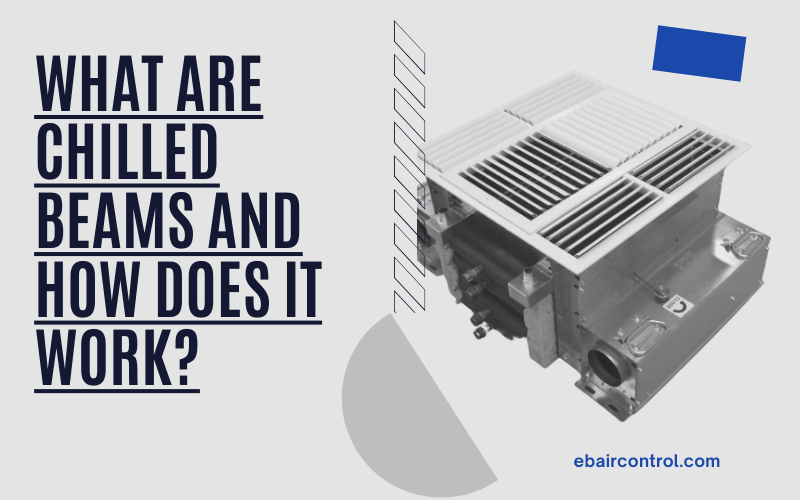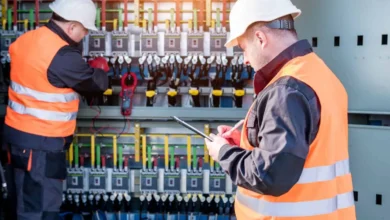What are Chilled Beams and How does it Work?

Almost every industrial plant with large instruments has an HVAC system installed. These systems create environmental comfort by regulating the indoor temperature and air quality. Without these systems, many industries would not be able to function at their full efficiency. One such HVAC is a chilled beam.
In this article, we will discuss what a chilled beam is and how chilled beams work in detail. We will also list different types of chilled beams generally used in industrial plants.
Chilled Beam – Definition
Chilled beams are a form of radiant cooling. This means it absorbs heat from a space and transferring it to a medium, usually a fluid or gas, to reduce the temperature. Chilled beams are a common form of radiant cooling, and can lower the temperature of a space by up to 40 degrees Fahrenheit.
As opposed to air-only conditioning systems, what a chilled beam uses is water to regulate the temperature. Water has a higher heat transfer coefficient than air and thus makes cooling more efficient.
Types of Chilled Beams
Primarily, there are three types of chilled beams. They are:
- Passive chilled beam.
- Active chilled beam.
- Integrated/multiservice chilled beam.
Let’s discuss each of them in brief.
1. Passive chilled beam:
The passive chilled beam has a fin and tube heat exchanger inside a housing. This whole setup hangs from the ceiling. By nature, hot air rises, and cold air settles down. Hence, hot air naturally reaches the ceiling without any help. This is then cooled down by the cold water passing through the tubes. Now, the cooled air settles down moving the hot air up and the process goes on in cycles. Thus, maintaining the ideal temperature.
2. Active chilled beam:
Active chilled beam has a similar setup, with a fin and tube heat exchanger inside a casing. The only main difference is that it requires an auxiliary air supply to keep the air flowing. The primary air induces the air from the indoor space to move through the cooling coils. Not only that, but an active chilled beam also provides proper ventilation support for the air. The primary air system helps move a higher amount of air than when done using the passive method. Hence, it is naturally more efficient than the previous method.
3. Integrated/multiservice chilled beams:
This kind of chilled beam can either be a passive chilled beam or an active chilled beam. It consists of many systems like lighting, sprinklers, cable pathways, speakers, and much more. It offers a complete solution for your building. There are holes and compartments for fitting different pieces of equipment directly onto it. Furthermore, there are many easily accessible maintenance spaces for quick and easy repair.
How chilled beams work?
Now that we have listed the commonly known types of chilled beams, let us describe how chilled beams work.
The principle behind chilled beams is ‘convective heat transfer. Convection is a type of heat transfer that works by the movement of a fluid. It is basically a radiator that is constantly cooled by cold water running through the tubes.
The answer to how chilled beams work is pretty simple. Hot air is naturally less dense and thus moves upwards. As said earlier in the passive chilled beam section, the hot air gets cooled by the cooling tubes and move downwards and the process repeats. In an active chilled beam, the only difference is that the system pushes the air towards the cooling system.
Chilled Beam Vs Fan Coil
A fan coil is one of the older techs for maintaining the temperature in a controlled space. Now, every company uses advanced HVAC systems to maintain environmental conditions. So, let us do a simple chilled beam vs fan coil comparison to understand it further.
1. Carbon emissions:
Due to new government regulations, every system you install must not exceed certain carbon emission levels. A chilled beam produces six times lower carbon emissions than traditional fan coils.
2. Cost:
You might think that fan coils are very much affordable than chilled beams. But, think further down the line. When you install an active or passive chilled beam, you initially invest more. But, when you think about the efficiency it delivers, you will understand that the additional cost is worth it. However, if you only need limited cooling, you can readily opt for fan coils at a much lower price.
3. Flexibility:
Fan coils win in this portion of chilled beams vs fan coils. You can install fan coils in any space easily without much prior preparation. Whereas, you need to carefully plan every minute detail to properly install a chilled beam.
4. Multiservice capabilities:
Both of them have the ability to house several types of equipment. But, you cannot deny that a chilled beam has more options when it comes to integrating various service modules. Unlike fan coils, you can install chilled beams in exposed construction.
Conclusion
For effective cooling, you need to have an HVAC system in your building. As the chilled beams do not need any terminal equipment, the entire system is quiet when compared to other HVAC systems. Plus, the maintenance of chilled beams is much easier. Hence, it is one of the best ways to cool your indoor spaces available.
EB air quality Inc manufactures high-quality HVAC products. We create custom designs and test them in-house to ensure the utmost efficiency. Contact us at 905-670-2277.






